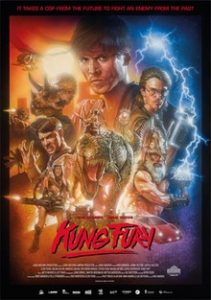Bob Dylan’s 115th Dream (1965) part 5
by Jochen Markhorst
VIII Almost like a Buster Keaton or something
I ran right outside, I hopped inside a cab I went out the other door, this Englishman said, "Fab" As he saw me leap a hot dog stand and a chariot that stood Parked across from a building advertising brotherhood I ran right through the front door like a hobo sailor does But it was just a funeral parlor and the man asked me who I was
 The music video for the Oscar winning song “Things Have Changed” (2000) amusingly intercuts footage of Dylan with sequences from the movie it was written for, from Wonder Boys. The video is also directed by the film director himself, Curtis Hanson, and lead actor Michael Douglas has been invited to contribute to the clip as well. Dylan’s acting is easy to characterise: Buster Keaton. Throughout the clip, Dylan keeps his face in the Keaton mode, his body language is almost identical. The resemblance is inescapable in the scenes in the car park before the diner; the straw hat Dylan has put on his head completes the imitation.
The music video for the Oscar winning song “Things Have Changed” (2000) amusingly intercuts footage of Dylan with sequences from the movie it was written for, from Wonder Boys. The video is also directed by the film director himself, Curtis Hanson, and lead actor Michael Douglas has been invited to contribute to the clip as well. Dylan’s acting is easy to characterise: Buster Keaton. Throughout the clip, Dylan keeps his face in the Keaton mode, his body language is almost identical. The resemblance is inescapable in the scenes in the car park before the diner; the straw hat Dylan has put on his head completes the imitation.
It doesn’t come out of the blue. On Wednesday, 5 November 2014, producer and writer Larry Charles is guest at Pete Holmes’ podcast You Made It Weird, and there Charles elaborates on a project Dylan wanted to undertake with him in the late 1990s: a surrealist comedy series for HBO. After an initial joint writing session, Charles dares to take the plunge. Together with Dylan, he pitches the idea on the executive floor of HBO, where it is indeed received enthusiastically. But in the elevator down Dylan has had enough already and says, to Charles’ disappointment: “I don’t wanna do it anymore. It’s too slapstick-y.” Larry can live with it; shortly afterwards he and Dylan write Masked And Anonymous (2003).
In short, Larry Charles is well-informed and has some right to speak when he makes statements about Dylan’s working methods. In the podcast he recalls how Dylan puts “this very ornate, beautiful box” on the table, he opens the box and dumps all these pieces of scrap paper on the table:
“It was hotel stationary, little scraps like from Norway, and from Belgium and from Brazil, you know places like that. And each little piece of paper had a line […]. I realized, that’s how he writes songs. He takes these scraps and he puts them together and makes his poetry out of that. He has all of these ideas and then just in a subconscious or unconscious way, he lets them synthesize into a coherent thing. And that’s how we wound up writing also. We wound up writing in a very ‘cut-up’ technique. We’d take scraps of paper, put them together, try to make them make sense, try to find the story points within it. And we finally wrote… a very elaborate treatment for this slapstick comedy, which is filled with surrealism and all kinds of things from his songs and stuff.”
And Dylan doesn’t just want to write it: “He wanted to star in it, almost like a Buster Keaton or something.” Eventually, Dylan will realise this ambition. Only not in a “surrealist comedy series for HBO”, but in the music video, shortly after this episode.
The love for slapstick, the deadpan presentation of fast-forward sequences of increasingly insane incidents, is distinctive in enough songs. In the Basement songs of course (“Million Dollar Bash”, “Yea! Heavy And A Bottle Of Bread”, to name but two), in mercurial songs like “On The Road Again”, and also in even older songs like “Motorpsycho Nightmare” or “Talking Bear Mountain Picnic Massacre Blues”.
“Bob Dylan’s 115th Dream” belongs to the same category, if only for this seventh verse. The protagonist flees from the restaurant with the exploding kitchen, finds shelter with a nice French girl, but her aggressive boyfriend chases him back onto the street, he gets into a taxi waiting for him and jumps out again on the other side – to continue with a hurdle across a hot dog stand and a chariot. A fast-forward sequence of farcical situations like a Buster Keaton scene, all in all. The weird metaphor “like a hobo sailor does” may be traced to this – both hobo and sailor are two Buster Keaton archetypes. Only the place of refuge, the shelter from the storm, is a Dylan original; there is not a single Keaton film with a funeral parlor as a setting.
IX What’s so bad about misunderstanding?
I repeated that my friends were all in jail, with a sigh He gave me his card, he said, "Call me if they die" I shook his hand and said, "Goodbye", ran out to the street When a bowling ball came down the road and knocked me off my feet A pay phone was ringing and it just about blew my mind When I picked it up and said, "Hello", this foot came through the line
 The 2015 Swedish cult film Kung Fury is a short (31 minutes), derailing homage to the martial art and police films of the 1980s, overflowing with visual gags, deliberately absurd plot holes solved with time travel hassle and an endless series of idiotic side characters like the god Thor, a Tyrannosaurus, whizkid “Hackerman” and Hitler.
The 2015 Swedish cult film Kung Fury is a short (31 minutes), derailing homage to the martial art and police films of the 1980s, overflowing with visual gags, deliberately absurd plot holes solved with time travel hassle and an endless series of idiotic side characters like the god Thor, a Tyrannosaurus, whizkid “Hackerman” and Hitler.
Clearly, the script aims at unconventionality, and quirky and imaginative it is, but director and writer David Sandberg, just as often, rightly considers the joke to be more important than originality…
Hitler : Give me ze phone!
[Punk gives Hitler his cell phone. Hitler dials the police precinct. Meanwhile, the Chief is looking at a police report]
Chief : What the hell is this?
[Phone rings]
Chief : Chief McNickles speaking.
Hitler : Is this ze police?
Chief : Yeah, this is the police.
Hitler : Fuck you!
[Hitler shoots through the phone, killing the Chief. He then continues to shoot at the whole precinct through the phone before Kung Fury storms in and shoots down the phone]
It is a classic Looney Toon gag that closes the slapstick interlude. The hurdle via the English taxi, over the hot dog stand and the chariot inspires analysts like Prof. Renza to reflect on “appreciation of his work in England’s rock scene”, and jumping over an American stereotype like the hot dog stand then says something about the “transcending” nature of his art, and “chariot” then signals something with criticism of militarism or something. Well, the importance of being earnest, as Oscar Wilde would say. In any case, its slapstick character is ignored. The continuation gives enough hints, though; the actions and the rebuttal of the undertaker (Call me if they die) and the bowling ball knocking over the protagonist are next, slapstick-y steps towards an increasingly anarchistic, Groucho Marx-like tone, culminating in the foot-through-the-telephone-line-gag.
No, this confetti-like salvo of wild idiosyncrasies seems rather to demonstrate what Larry Charles notices more than thirty years later: “He takes these scraps and he puts them together and makes his poetry out of that.” In 2014, when Charles recounts this, he is still impressed by Dylan’s response to his cautious criticism. During the joint writing of that slapstick project, Charles remembers, Dylan trots out a scene about a “pig with a wig”.
“I said, Bob, even in this thing, that doesn’t make any sense. No one’s gonna understand that. And he said: what’s so bad about misunderstanding?”
…Dylan reveals his fondness for the next step in comedy; the dry, pointless humour as perfected by comedians like Lenny Bruce and Andy Kaufman.
Still, the first love, the love for good old-fashioned slapstick humour with visual gags never dies. Fifty-five years later, in “Murder Most Foul”, Dylan requests: “Play Buster Keaton, play Harold Lloyd.”
To be continued. Next up: Bob Dylan’s 115th Dream part 6: Caput vel cauda
————
Jochen is a regular reviewer of Dylan’s work on Untold. His books, in English, Dutch and German, are available via Amazon both in paperback and on Kindle:
- Blood on the Tracks: Dylan’s Masterpiece in Blue
- Blonde On Blonde: Bob Dylan’s mercurial masterpiece
- Where Are You Tonight? Bob Dylan’s hushed-up classic from 1978
- Desolation Row: Bob Dylan’s poetic letter from 1965
- Basement Tapes: Bob Dylan’s Summer of 1967
- Mississippi: Bob Dylan’s midlife masterpiece
- Bob Dylan’s Greatest Hits
- John Wesley Harding: Bob Dylan meets Kafka in Nashville
- Tombstone Blues b/w Jet Pilot: Dylan’s lookin’ for the fuse
- Street-Legal: Bob Dylan’s unpolished gem from 1978

Nevertheless such comedy comments on social/ economic/ cultural values
such as businessmen going after your money even if they have to wait until you die….
The undertaker – the last person to let you down.
‘Slapstick’ and ‘Burlesque’ are closely related.
”Slapstick” and ”Burlesque” are closely related.
As in repeating yourself, for example (lol)